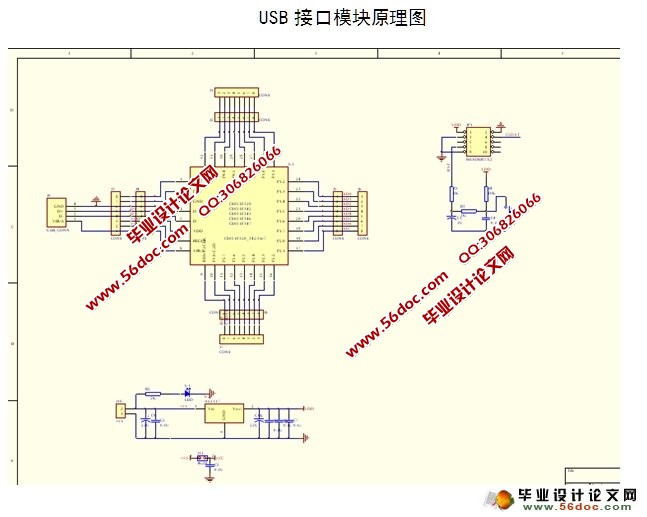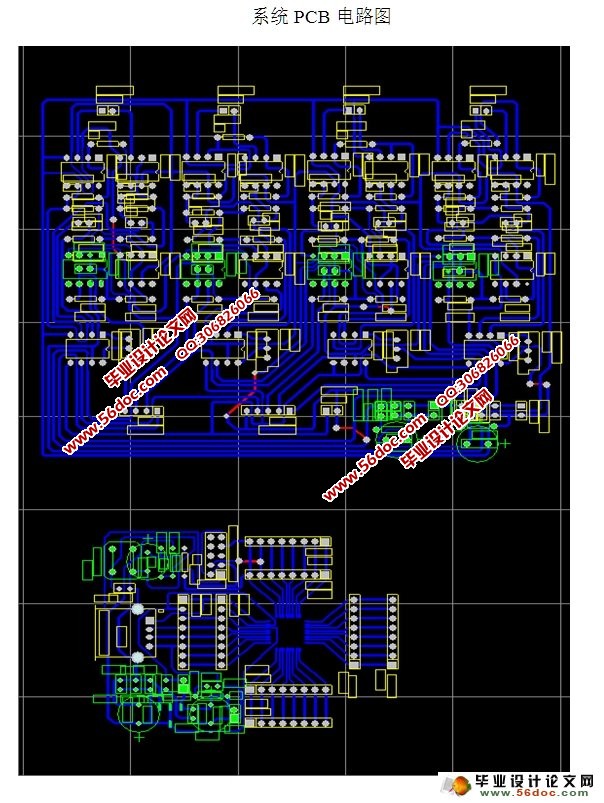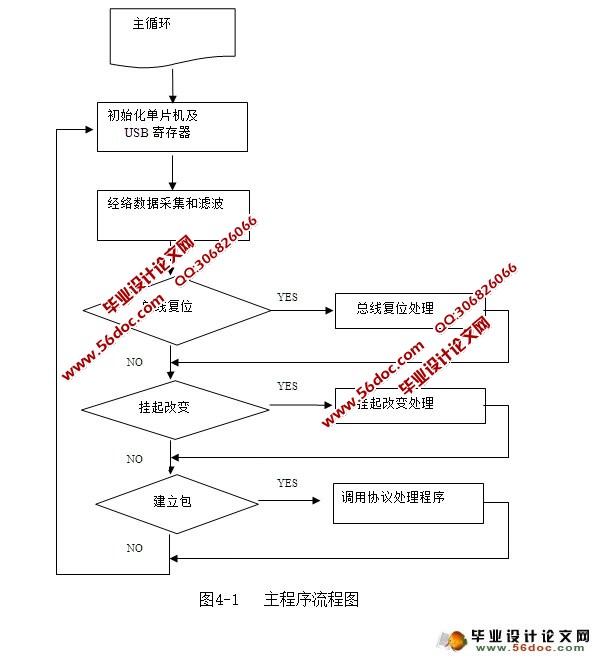基于USB的经络信号的检测系统与设计(附PCB图,电路原理图)

1.无需注册登录,支付后按照提示操作即可获取该资料.
2.资料以网页介绍的为准,下载后不会有水印.资料仅供学习参考之用.
密 惠 保
基于USB的经络信号的检测系统与设计(附PCB图,电路原理图)(任务书,开题报告,中期报告,外文翻译,论文18000字)
摘 要
中医经络学说经过数千年的研究和发展,已经取得很大的成就,逐步得到了世界各国的广泛认同和接受。但是传统中医学的经络情况不够直观。由于电信号特征较明显、易于获得,又是与经络密切相关的神经、循环系统的明显特征之一,因此,针对经络系统的电信号动态USB传输和波形的显示的设计,应能更有利于发现特征而触及本质。
针对把微弱的经络信号转换为电信号,并且进行相应处理,使系统能够实时的反应经络图像的问题,基于USB技术的经络数据采集系统的设计严格遵循USB协议,采用TI公司生产的内核兼容8051带有闪存的高性能芯片C8051F320作为微控制器采集信号,该芯片自带的17路速度为200K的10位A/D转换器采集信号,同时该芯片还集成USB2.0接口,方便的完成了系统的硬件电路设计。
本系统中单片机系统主要完成信号采集、数据通信和实现USB接口通信;微机完成数据接收、显示等功能。软件设计中采用C51语言编写数据采集程序和对USB接口芯片进行协议处理及数据交换的程序。上位机的数据处理程序应用visual basic语言编写。
关键词: C8051f320;数据采集;USB(通用串行总线);驱动程序
Abstract
Chinese meridian theory After several thousand years of research andevelopment, has made great achievements in the world, gradually gained widespread recognition and acceptance.however, traditional Chinese medicine in the meridian not intuitive. The signal characteristics of a significant, accessible, and is closely related to thenerve Meridian, one of the obvious features of the circulatory system, therefore, themeridian system for transmission and dynamic signal waveform display design, should be able to find more features touch nature.
Aiming at transforming the faint pulse signal to electricity signal And processing it and the system responding the real-time pulse image, this Pulse Data Collecting System based on USB technique strictly follows USB2.0 protocol.Has adopt the core 8051 compatible high-performance chip C8051F320 with lightning exist to collect a signal as tiny controller that the TI company produces to examine , has been a chip's turn to be that 10 place A/D converter of 200 K collect a signal from 17 road speed of belt , has owed a chip the fairly integrated USB2.0 interface at the same time , has accomplished systematic hardware wiring design conveniently.
In this system,the microchip system focuses on sampling signals and data communication, c8051f320 fulfils USB interfacing comunication,and the microcomputer completesdata acceptance,storagetodatabase,data processing,display and other functions.The software designs adopt assembly language, C51language to compile data sampling program andprograms on protocol processingand data transfer conducted to USB interfacingchip. The data processing program for upper computer is compiled with visual basic language.
Keywords :C8051f320;datasample;USB(UniversalSerialBus);driverprogram
本课题的主要内容有:
1.掌握经络传感器的性能结构,对其进行优化使之适于后续系统。
2,分析C0851F320的性能,掌握其使用方法。
3.设计经络数据采集系统的硬件部分及软件部分。
4.对经络数据采集系统进行调试。
[版权所有:http://think58.com]



目 录
1 绪论……………………………………………………………………… 1
1.1 中医经络概述…………………………………………………………1
[来源:http://www.think58.com]
1.2 本研究课题的意义及国内外发展状…………………………………1
1.3 本研究课题的来源及主要研究内容…………………………………2
2 系统整体方案设计…………………………………………………… 3
2.1 系统的总体结构设计…………………………………………………3
2.1.1信号采集模块……………………………………………………3
2.1.2 A/D转换器的选择………………………………………………4
[资料来源:http://www.THINK58.com]
2.2 USB接口模块…………………………………………………………4
2.2.1几种串行总线的比较……………………………………………4
2.2.2 USB接口模块的设计……………………………………………5
2.3软件设计方案………………………………………………………… 6
2.4本章小结……………………………………………………………… 6
3 硬件分析与设计……………………………………………………… 7 [来源:http://think58.com]
3.1 系统概述………………………………………………………………7
3.1.1经络导联…………………………………………………………7
3.1.2经络信号的特点及对放大电路的要求…………………………7
3.2 总体电路框图…………………………………………………… 7
3.3 具体单元电路设计………………………………………………… 8
3.3.1 前置放大电路的设计………………………………………… 8
3.3.2 放大方案的选择………………………………………………8
3.3.3方案选择及元器件选择……………………………………… 11
3.4 共模信号抑制电路………………………………………………… 12
3.5.1 定义…………………………………………………………… 12
3.4.2右腿驱动电路……………………………………………………12
3.4.3元器件参数计算…………………………………………………13 [来源:http://www.think58.com]
3.5 工频50Hz的滤除电路……………………………………………… 15
3.6 后级放大电路…………………………………………………………16
3.7 总结和讨论……………………………………………………………17
4 软件分析与设计……………………………………………………… 18
4.1 系统总体设计…………………………………………………………18
4.2 固件程序设计…………………………………………………………18
[资料来源:http://THINK58.com]
4.2.1 USB接口固件设计……………………………………………… 18
4.2.2 单片机主程序设计………………………………………………19
4.2.3设备配置信息…………………………………………………… 23
4.3设备驱动程序………………………………………………………… 24
4.3.1 USB驱动程序层………………………………………………… 24
4.3.2 函数驱动程序……………………………………………………25
[资料来源:http://www.THINK58.com]
4.3.3 USB设备被发现的过程………………………………………… 25
4.3.4 Windows驱动程序描述………………………………………… 26
4.3.5 USB设备驱动程序设计………………………………………… 27
4.4 应用软件的设计……………………………………………………… 28
4.5 本章小结……………………………………………………………… 29
5 经络数据采集系统的调试………………………………………… 30
5.1 调试步骤……………………………………………………………… 30
5.2 硬件的调试与验证…………………………………………………… 30
5.3 软件的调试与验证…………………………………………………… 30
5.4 抗干扰措施…………………………………………………………… 31
5.4.1 硬件抗干扰措施…………………………………………………31
5.4.2 软件抗干扰措施…………………………………………………32
5.5本章小结…………………………………………………………………33
结论……………………………………………………………………………34
谢 辞…………………………………………………………………………35
参考文献…………………………………………………………………… 36
[版权所有:http://think58.com]
